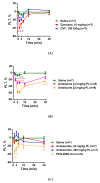Complement Activation-Related Pathophysiological Changes in Anesthetized Rats: Activator-Dependent Variations of Symptoms and Mediators of Pseudoallergy
- PMID: 31505853
- PMCID: PMC6767111
- DOI: 10.3390/molecules24183283
Complement Activation-Related Pathophysiological Changes in Anesthetized Rats: Activator-Dependent Variations of Symptoms and Mediators of Pseudoallergy
Abstract
Complement (C) activation can underlie the infusion reactions to liposomes and other nanoparticle-based medicines, a hypersensitivity syndrome that can be partially reproduced in animal models. However, the sensitivities and manifestations substantially differ in different species, and C activation may not be the only cause of pathophysiological changes. In order to map the species variation of C-dependent and -independent pseudoallergy (CARPA/CIPA), here we used known C activators and C activator liposomes to compare their acute hemodynamic, hematological, and biochemical effects in rats. These C activators were cobra venom factor (CVF), zymosan, AmBisome (at 2 doses), its amphotericin B-free vehicle (AmBisombo), and a PEGylated cholesterol-containing liposome (PEG-2000-chol), all having different powers to activate C in rat blood. The pathophysiological endpoints measured were blood pressure, leukocyte and platelet counts, and plasma thromboxane B2, while C activation was assessed by C3 consumption using the Pan-Specific C3 assay. The results showed strong linear correlation between C activation and systemic hypotension, pointing to a causal role of C activation in the hemodynamic changes. The observed thrombocytopenia and leukopenia followed by leukocytosis also correlated with C3 conversion in case of C activators, but not necessarily with C activation by liposomes. These findings are consistent with the double hit hypothesis of hypersensitivity reactions (HSRs), inasmuch as strong C activation can fully account for all symptoms of HSRs, but in case of no-, or weak C activators, the pathophysiological response, if any, is likely to involve other activation pathways.
Keywords: amphotericin B; blood cell count; blood pressure; cobra venom factor; complement activation; infusion reactions; thromboxane; zymosan.
Conflict of interest statement
The authors declare no conflict of interest.
Figures






Similar articles
-
Features of complement activation-related pseudoallergy to liposomes with different surface charge and PEGylation: comparison of the porcine and rat responses.J Control Release. 2014 Dec 10;195:2-10. doi: 10.1016/j.jconrel.2014.08.009. Epub 2014 Aug 19. J Control Release. 2014. PMID: 25148822
-
Acute physiological changes caused by complement activators and amphotericin B-containing liposomes in mice.Int J Nanomedicine. 2019 Feb 26;14:1563-1573. doi: 10.2147/IJN.S187139. eCollection 2019. Int J Nanomedicine. 2019. PMID: 30880965 Free PMC article.
-
Comparison of complement activation-related pseudoallergy in miniature and domestic pigs: foundation of a validatable immune toxicity model.Nanomedicine. 2016 May;12(4):933-943. doi: 10.1016/j.nano.2015.12.377. Epub 2016 Jan 6. Nanomedicine. 2016. PMID: 26767512
-
Animal models of complement-mediated hypersensitivity reactions to liposomes and other lipid-based nanoparticles.J Liposome Res. 2007;17(2):107-17. doi: 10.1080/08982100701375118. J Liposome Res. 2007. PMID: 17613700 Review.
-
Humanized cobra venom factor: experimental therapeutics for targeted complement activation and complement depletion.Curr Pharm Des. 2007;13(28):2916-26. doi: 10.2174/138161207782023748. Curr Pharm Des. 2007. PMID: 17979736 Review.
Cited by
-
Conjugation Chemistry Markedly Impacts Toxicity and Biodistribution of Targeted Nanoparticles, Mediated by Complement Activation.Adv Mater. 2025 Feb;37(5):e2409945. doi: 10.1002/adma.202409945. Epub 2024 Dec 11. Adv Mater. 2025. PMID: 39663706 Free PMC article.
-
Human Clinical Relevance of the Porcine Model of Pseudoallergic Infusion Reactions.Biomedicines. 2020 Apr 8;8(4):82. doi: 10.3390/biomedicines8040082. Biomedicines. 2020. PMID: 32276476 Free PMC article. Review.
-
To PEGylate or not to PEGylate: Immunological properties of nanomedicine's most popular component, polyethylene glycol and its alternatives.Adv Drug Deliv Rev. 2022 Jan;180:114079. doi: 10.1016/j.addr.2021.114079. Epub 2021 Dec 10. Adv Drug Deliv Rev. 2022. PMID: 34902516 Free PMC article. Review.
-
The Critical Choice of Animal Models in Nanomedicine Safety Assessment: A Lesson Learned From Hemoglobin-Based Oxygen Carriers.Front Immunol. 2020 Oct 26;11:584966. doi: 10.3389/fimmu.2020.584966. eCollection 2020. Front Immunol. 2020. PMID: 33193403 Free PMC article. Review.
-
Lessons learned from immunological characterization of nanomaterials at the Nanotechnology Characterization Laboratory.Front Immunol. 2022 Oct 10;13:984252. doi: 10.3389/fimmu.2022.984252. eCollection 2022. Front Immunol. 2022. PMID: 36304452 Free PMC article. Review.
References
MeSH terms
Substances
Grants and funding
LinkOut - more resources
Full Text Sources
Miscellaneous

